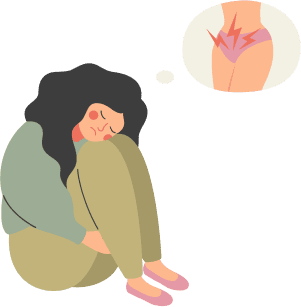Support Centre
Vaginal dryness and sore vulva
Menopause symptoms and treatments.
Vaginal dryness and sore vulva
Another symptom that can affect our genitals is dryness and this may include a red, sore or itchy vulva too. The collective term for these symptoms is Genito-urinary Syndrome of Menopause or GSM, and it refers to UTIs, painful sex and incontinence too.
The vagina is an area that likes lots of oestrogen, so it can suffer significantly when it’s no longer in good supply. It is estimated that around 70% of women suffer with GSM but only 7% receive treatment for it, despite there being several effective treatments available.
You don’t have to put up with a dry and sore vagina and vulva, or painful sex and UTIs at menopause. It doesn’t have to be put up with as ‘just a normal part of aging’ and plenty can be done to help.

Book a consultation.
If you have any questions or concerns about your health, please book a consultation.
Don’t worry alone, we’re here to help.
Ways to help
- The best treatment is to use oestrogen directly in the vagina and around the vulva in the form of a cream, gel, pessary or ring. This helps restore the tissue and natural feel of the area, it helps to lubricate the vagina, reduce soreness and irritation of the vulva and will also help with UTIs, incontinence, and sex.
- You could also consider taking HRT in the form of a patch or gel which will top up your hormones in your whole body and help with many other symptoms of menopause too.
- Dr Natalie Summerhill will be happy to discuss these treatments with you
- Use plenty of lube for penetrative sex. Choose skin-kind ones that don’t contain glycerin, petroleum, parabens, scents, flavours or dyes. You can spread it over the vulva as well, and spread lots on anything entering the vagina (penis/fingers/sex toy).
- Try vaginal moisturisers. These don’t contain hormones and aren’t for sex, they are to hydrate the area on a regular basis to make things more comfortable down below. Use them regularly, (but at different times if also using vaginal oestrogen treatment).
Keep your vagina and vulva happy and healthy by avoiding perfumed products, not douching, wearing breathable comfortable underwear, not over-doing the pubic landscaping (hair helps keep bacteria and sweat away!), cut down on alcohol and smoking, and drink plenty of water.
- Anger and irritability
- Anxiety and panic
- Bleeding from sex
- Brain fog and memory loss
- Depression
- Fatigue and lack of motivation
- Headaches and migraine
- Hot flushes, night sweats and palpitations
- Joint pain and muscle aches
- Low mood and crying
- Low self esteem and lack of confidence
- Low sex drive and painful sex
- Numbness and tingling
- Palpitations
- Period changes
- Skin changes
- Soreness and pain during intercourse
- Trouble sleeping
- Urinary habits and incontinence
- Vaginal dryness and sore vulva
- Women’s Health